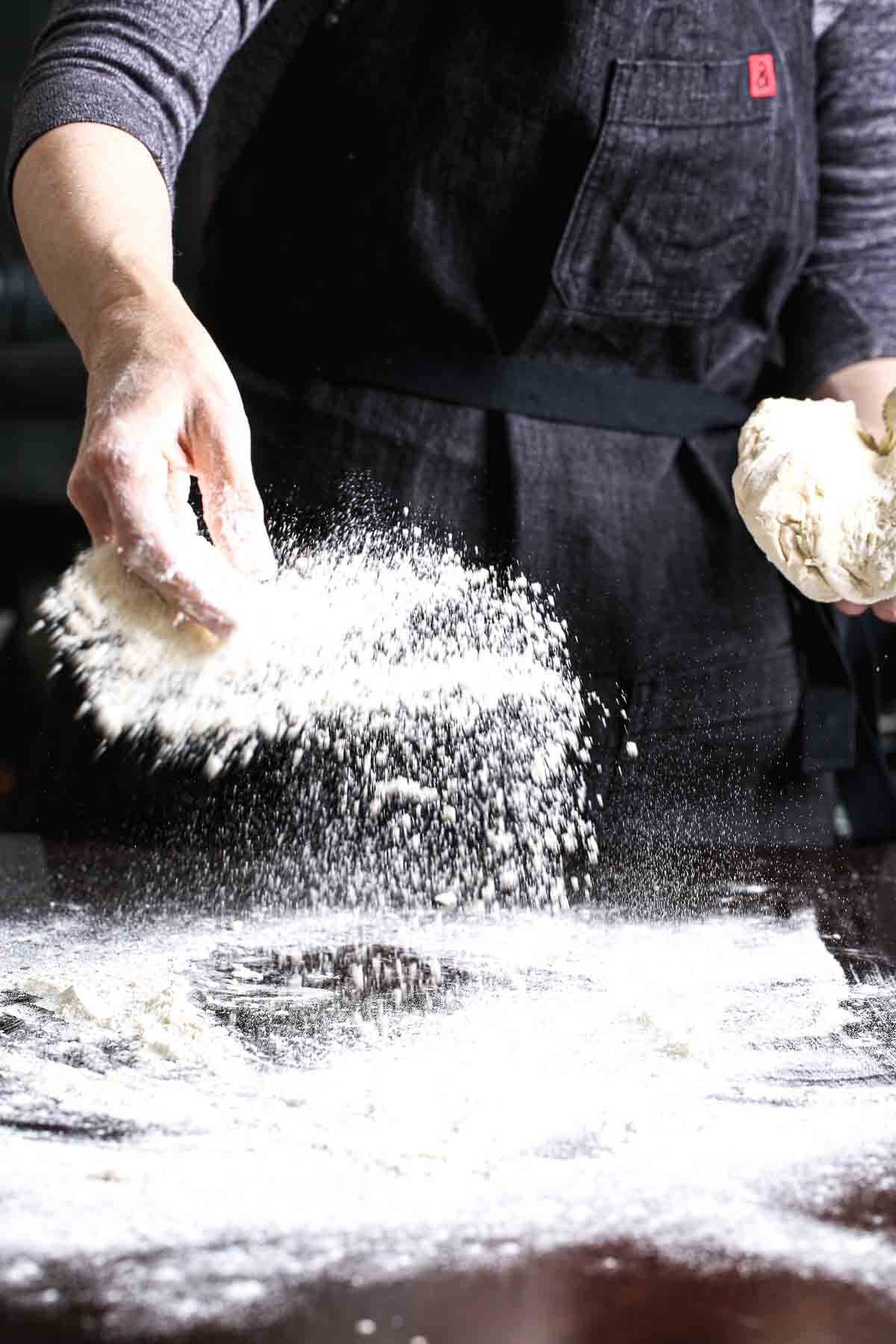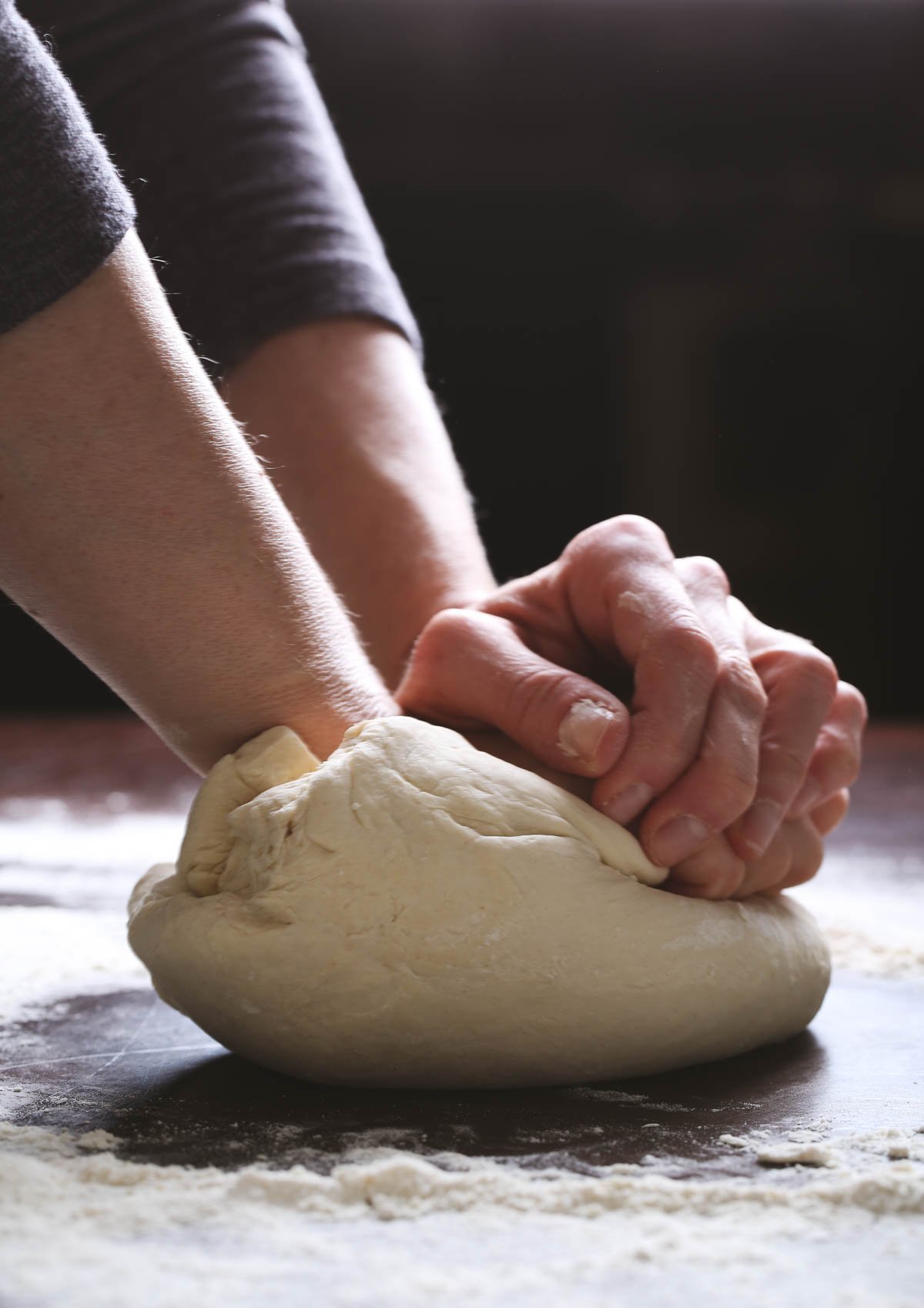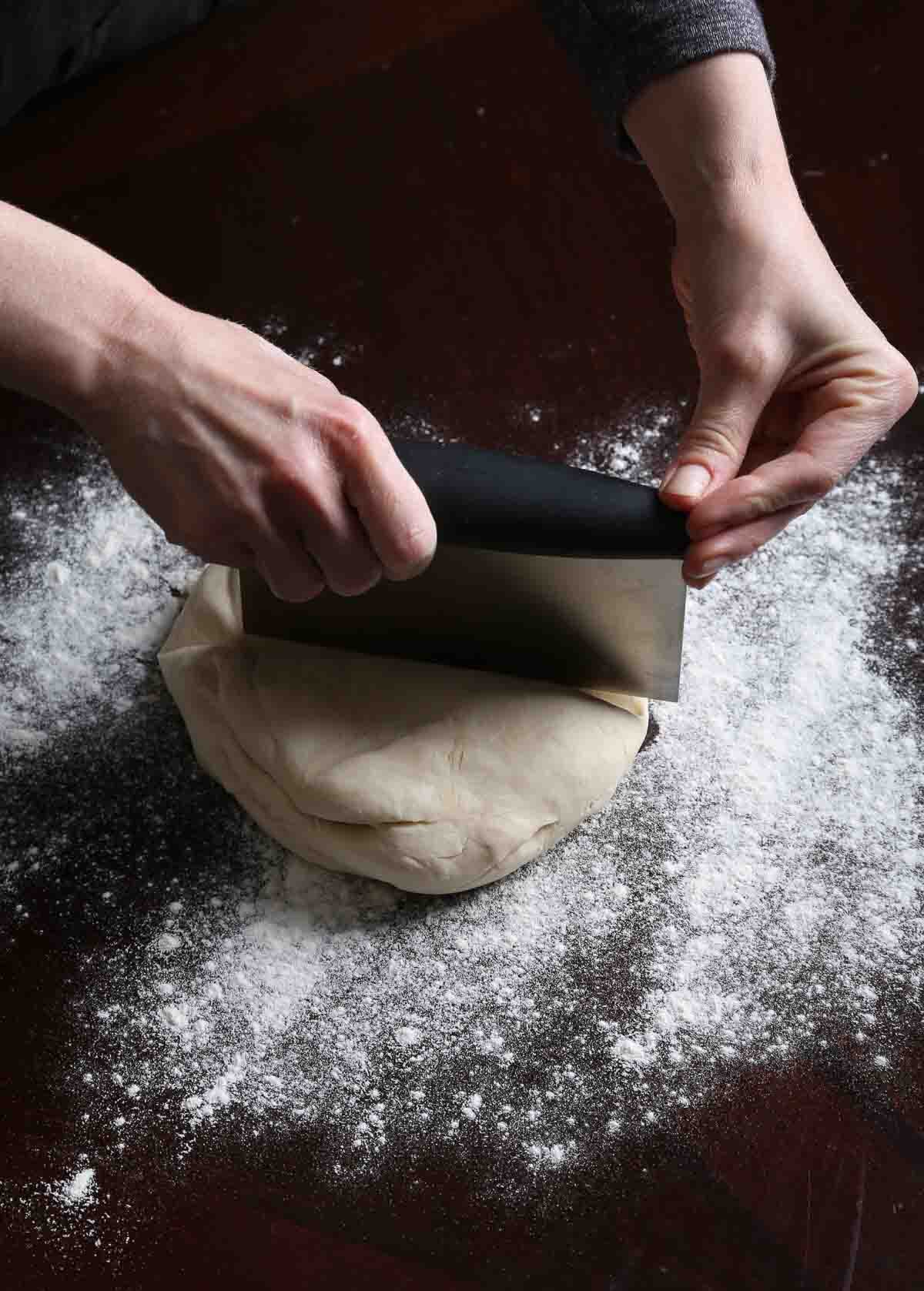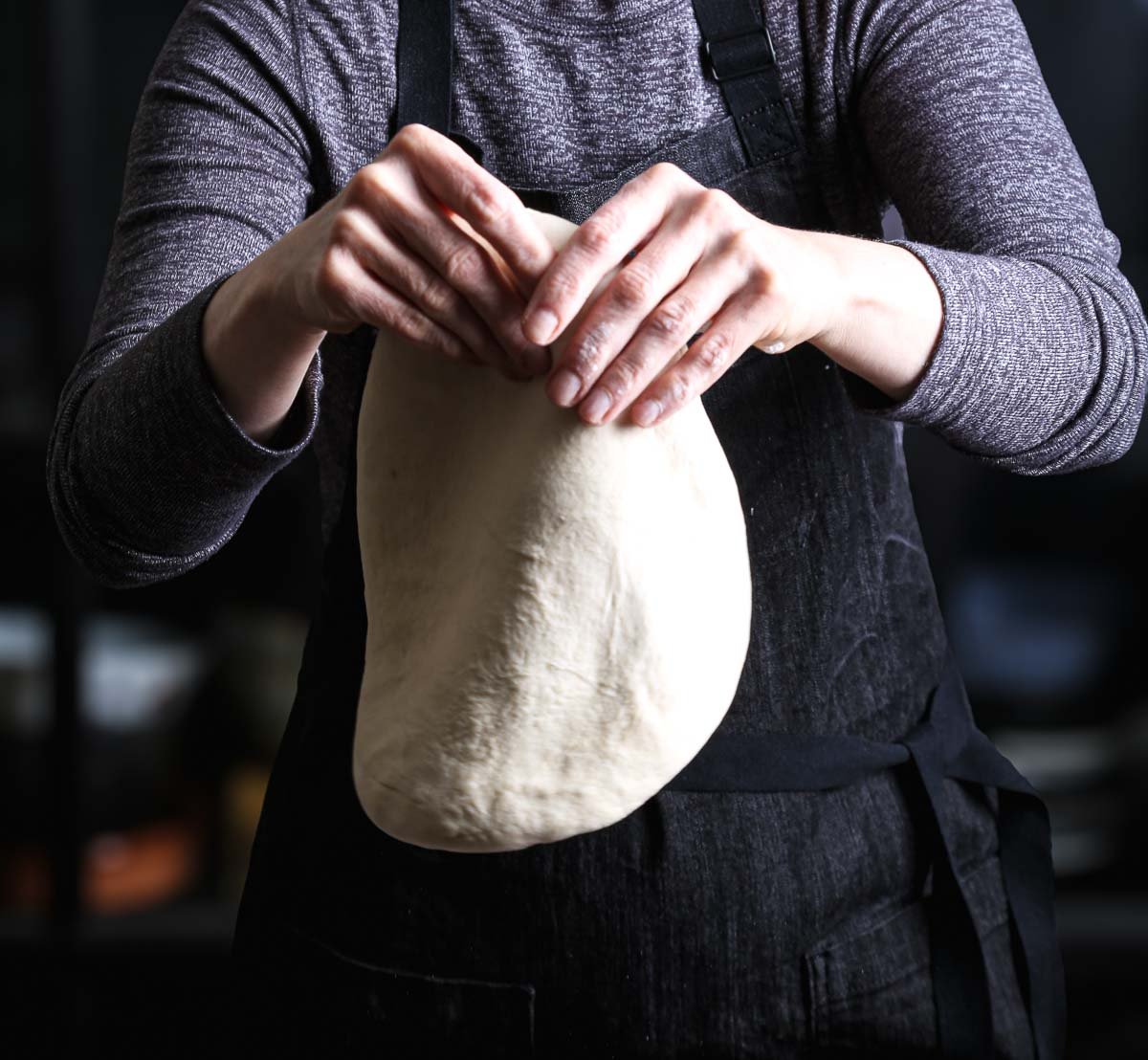Good vegan pizza dough sets the stage for a great homemade pie—and this one does it with just flour, water, yeast, and salt. The result? A crust that bakes up golden, chewy, and ready to carry whatever you put on top of it.

Good pizza dough is both science and craft. Get the ratio of flour, water, salt, and yeast right, and the rest is time and technique. This version is lean and simple: strong enough to crisp at the edges, hydrated enough to stay chewy in the middle, and forgiving enough for weeknight pizza without fuss.
There aren’t really any tricks or fancy ingredients here; rather, it’s about knowing what each one does. Flour gives you structure, yeast gives you lift, salt reins in flavor, and fermentation builds the depth. Knead, rest, bake, repeat—and you’ll have dough that’s not just a vehicle for a wide array of vegan pizza toppings, but the reason the whole pizza works.
Why This Vegan Pizza Dough Recipe Works
At its core, pizza dough is just flour, water, yeast, and salt—but how you let them interact determines whether your crust is flat and bland or crisp, chewy, and full of character. Here’s why this method delivers:
- Perfect texture balance: A simple ratio of flour to water creates a crust that bakes up golden, chewy, and crisp all at once. This is vegan comfort food at its best!
- Flavor through fermentation: As the dough rests, yeast converts the flour’s starches into simple sugars. That process creates gas (for lift) and builds subtle flavor you can’t get any other way.
- Time equals flavor: A couple hours at room temp is all you need for rise and structure.
- Naturally vegan: Traditional pizza dough doesn’t use eggs or dairy—this crust stays plant-based without substitutions.
- Beginner-friendly method: Easy steps and no special tools required. If you can stir, knead, and wait, you can master this homemade vegan pizza crust.
Key Ingredients
This dough only asks for a handful of basics, but each one matters. 00 flour keeps the texture light and pliable, so the crust stretches thin without tearing. Yeast brings the rise, salt reins in the flavor, and a touch of olive oil helps the edges bake up golden. Here’s more about what each one of them does:

- Tipo 00 Flour: This is the gold standard for pizza dough. In Italian milling, “00” refers to the grind size—the finest you can buy. It’s made from soft wheat, ground so fine it feels almost like talc in your hand. That powdery texture means the dough stretches without snapping back and bakes into a crust that’s thin, crisp at the edges, and tender in the middle.
- Salt: More than seasoning, salt keeps the yeast in check so the dough rises evenly—and makes the crust taste like pizza instead of cardboard.
- Active Dry Yeast: This is the engine. Yeast feeds on the flour, releasing gas for rise and building subtle flavor as it rests. Time is what transforms it from flat to full of character.
- Olive Oil: Olive oil doesn’t go into the dough itself, but it’s essential for the process. It prevents sticking during the rise, helps edges bake golden, and adds a light fruitiness that plays well with any topping.
How To Make
Making this vegan pizza dough isn’t complicated—it just asks for a little time and a light touch. Once you’ve mixed, kneaded, and let it rest, you’re only a short bake away from golden, chewy crust that smells like your favorite pizzeria. Here’s a step-by-step:


Step 1: Mix the Dough – Combine the flour and salt in a large bowl. Stir the yeast into lukewarm water until dissolved, then pour it in. Mix until a rough, shaggy dough forms. The water should feel warm but not hot to the touch—think bathwater, not tea. Aim for 95–105°F.


Step 2: Knead – Turn the dough onto a floured surface and knead for 8–10 minutes, until smooth and elastic. It should spring back when poked and feel tacky but not sticky.

Step 3: First Rise – Tuck the dough into a lightly oiled bowl, cover, and let it rise at room temperature for about 1½–2 hours, or until doubled. This is where flavor and structure start to build.


Step 4: Divide & Rest – Punch the dough down gently, then divide it into two balls. Cover and let them rest for 20 minutes so the gluten relaxes—this makes stretching easier.

Step 5: Shape – Working with one ball at a time, press and stretch into a 10–12 inch circle. Let gravity do the work by letting it hang or draping the dough over your knuckles while turning it slowly. Rustic edges are part of the charm, so don’t feel like it needs to be a perfect circle.

Step 6: Top & Bake – Place the dough on parchment, add sauce and your favorite vegan pizza toppings, then brush the edges with olive oil. Transfer to a preheated pizza stone or steel for maximum crisp, or use a lightly oiled baking sheet if that’s what you’ve got. Bake at 450–475°F for 8–12 minutes, until the crust is golden and blistered.
Pro Tips For The Best Vegan Pizza Dough
Even with a simple recipe, a few small moves can take your crust from ordinary to extraordinary. Think of these as guardrails that keep your vegan pizza dough consistent, flavorful, and a little more forgiving every time you make it.
- Check the water temp: Yeast likes it warm, not hot. Aim for bathwater warm (around 100°F). Too cool, and the rise drags; too hot, and you’ll kill the yeast before it gets going.
- Rise to the occasion: For same-day vegan pizza dough, a 2-hour room-temp rise works great. For deeper flavor and easier stretching, knead the dough, let it rise at room temperature for about 2 hours, divide into balls, then refrigerate for up to 3 days before bringing to room temperature and shaping. See note about cold fermenting below.
- Knead with intention: You’re building gluten, so go slow and consistent. Smooth and elastic is your cue that it’s done—it should spring back gently when poked.
- Rest before stretching: That 20-minute pause after dividing the dough? Don’t skip it—it relaxes gluten so the dough doesn’t snap back while you shape it.
- Bake hot, bake fast: A preheated stone or steel at 450–475°F gives you that golden bottom and blistered edge. The hotter the surface, the better the crust.
How To Cold Ferment Pizza Dough
If you want a deeper, more flavorful dough, cold-ferment it. That simply means slowing the yeast way down so it has days, not hours, to build flavor. The chill encourages subtle tang, better browning, and dough that stretches without snapping back.
To do this, mix and knead the dough, then cover it and let it rise at room temperature for about 2 hours. This kick-start keeps the yeast from stalling once it’s cold. After that, divide into balls, wrap them snugly in cling wrap, tuck into an airtight container, and refrigerate for up to 3 days. When you’re ready to bake, let the dough rest until it comes fully to room temperature—usually about 30–60 minutes depending on your kitchen—before shaping.
FAQs
Yes. After the first rise, divide and shape the dough into balls. Lightly oil each one, slip into a zip-top bag, and freeze for up to 3 months. Thaw overnight in the fridge, then let rest at room temp for 30 minutes before stretching and baking.
At room temperature, plan for 1½–2 hours, or until the dough doubles in size. For more flavor and easier stretching, try cold fermenting in the fridge. This slow rise creates complex flavor and a crust that browns beautifully.
A sluggish rise usually means one of three things: your yeast has expired, the water was too hot/cold, your kitchen is too cool, or you didn’t give it enough time. Make sure your yeast is fresh, the water is about 100°F, and the dough is kept somewhere draft-free. If it’s chilly, expect the rise to take longer.

For More Bread Recipes, Check These Out Next!
Did you try this vegan pizza dough recipe? Let us know! Drop a comment and a star rating below—your feedback helps others and makes our day.
Get This Recipe In Your Inbox
Share your email, and we’ll deliver it straight to your inbox.
Plus, enjoy new content every week as a bonus!

Easy Vegan Pizza Dough
- Total Time: 2 hours 30 minutes
- Yield: 2 (10–12 inch) pizzas, about 4 servings
- Diet: Vegan
Description
This vegan pizza dough is everything you want in a crust—crispy at the edges, chewy in the middle, and sturdy enough to hold generous toppings. It’s made with just flour, water, yeast, and salt, so the process is simple but the results taste bakery-level. Whether you’re after a classic margherita or a fully loaded pie, this dough gives you the perfect base.
Ingredients
- 4 cups Tipo 00 flour
- 1 teaspoon salt
- 1/2 tsp active dry yeast, dissolved in 1 1/4 cups lukewarm water
- Olive oil, for oiling the bowl and brushing the crust
Instructions
- Mix the dough: In a large bowl, combine the 00 flour and salt. Stir the yeast into the lukewarm water until dissolved. Pour into the flour mixture and stir with a sturdy spatula until a shaggy dough forms.
- Knead: Transfer to a floured surface and knead for 8–10 minutes, until the dough is smooth and elastic. (It should spring back when poked and feel slightly tacky but not sticky.)
- First rise: Place in a lightly oiled bowl or glass container, cover, and let rise at room temperature for 1½–2 hours, or until doubled in size.
- Divide & rest: Punch down gently, then divide into 2 portions. Form into balls, cover, and let them rest for 20 minutes. This relaxes the gluten and makes stretching easier.
- Shape your pizza: Working with one ball at a time, press and stretch the dough into a 10–12 inch circle. Use gravity by letting the dough hang over your knuckles—no need to overwork it.
- Add toppings: Place the pizza onto parchment paper. Add sauce and vegan pizza toppings of your choice. Brush the edges with olive oil and sprinkle with a little coarse salt, if desired.
- Bake: Preheat a pizza stone or steel at 450–475°F for at least 20 minutes. Transfer the pizza (on parchment) to the stone, then slide the parchment out after 2–3 minutes if you want maximum crisp. Alternatively, bake on a lightly oiled baking sheet for 10–12 minutes. In either case, the crust should be golden and crispy.
Notes
- Hydration check: The dough should feel tacky, not sticky. Too wet? Dust with a little flour. Too dry? Knead in a teaspoon of water at a time.
- Make-ahead: After the first rise, refrigerate the dough up to 3 days. This slow fermentation builds flavor. Let it rest 30-60 minutes at room temperature before shaping.
- Freezing: After the first rise, portion into balls and freeze in oiled zip-top bags for up to 3 months. Thaw in the fridge overnight, then let rest before shaping.
- Baking surface: A preheated pizza stone or steel gives the best oven spring and crisp bottom. If you don’t have one, a lightly oiled baking sheet works too—it produces a slightly softer crust but still bakes up golden and delicious.
- Batch baking: Two pizzas can bake at once if your oven fits, but rotate halfway through. For maximum crispiness, bake one at a time.
- Storage: Wrap cooled pizza tightly and refrigerate for up to 3 days. Freeze slices in a single layer, then transfer to a bag for longer storage.
- Reheating: Reheat at 375°F on a sheet pan or a stone for 8–10 minutes, until the crust crisps up at the toppings are warmed through. Avoid the microwave—it steams the crust and makes it gummy.
- Prep Time: 20 minutes
- Cook Time: 12 minutes
- Category: Dinner
- Method: Kneaded, Baked
- Cuisine: Italian
This recipe was originally published in 2020 and updated in 2025 with clarified instructions and tips.







This looks simply amazing! I love how you can have a really hearty “meaty” delicious pizza which is entirely vegan:)